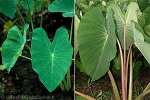Cook Islands Biodiversity Database
Species Page
Colocasia esculenta
TaroWetland Taro
Multimedia & Additional Resources
| Type | Description | Download |
| Plant | 51KB | |
| Taro cultivation on raised beds | 88KB | |
| Taro cultivation in terraced pond-fields | 56KB |
General Information
Cook Islands Distribution
| Southern Group: Present Makatea: Present | ||||||||
RR |
MG |
AT |
MK |
MT |
AK |
PL |
TK |
MN |
++++ |
++++ |
++++ |
+++ |
++? |
++++ |
P |
X |
|
| Northern Group: Present | |||||
TN |
MH |
RK |
PK |
NS |
SW |
+ |
P |
++? |
++++ |
++? |
- |
Pests & Hosts
| Relationship | Pests |
| Pathogen | Dasheen mosaic virus (DsMV), Taro bacilliform virus (TaBV), |
Scientific Taxonomy
Colocasia esculenta Linnaeus
SYNONYMS: Colocasia esculenta var. antiquorum; Colocasia antiquorum; Arum esculenta; Arum colocasis
TAXONOMY: PLANTAE; ANTHOPHYTA (=Angiospermae); LILIOPSIDA (=Monocotyledones); ARECIDAE; Arales; ARACEAE
More Information
SIGNIFICANCE NOTES -. Comment: NBSAP - Atiu (Taro Atiu/Niue, 1 of 5 domestic)
POSITIVE SIGNIFICANCE: Food (Root 4+), Medicine
NEGATIVE SIGNIFICANCE: Poisonous to eat older leaves raw - moderate
IDENTIFICATION: Stemless herb to 1.5m grown for its edible corm. LEAVES massive, to 50x30cm, heart-shaped (large anterior lobe with 2 small posterior lobes), peltate (=stalk connects to underside near the centre), waxy, edge withoout teeth, tip downward at night; stalk to 1.5m. ROOT (=corm, a swollen underground stem) ovoid, edible after cooking.
GENERAL NOTE: Taro contains calcium oxalate crystals that cause a burning sensation in the mouth as they pierce the mucous menbranes. The concentration of crystals is greater in mature leaves than in teh corm. The crystals are dissolved by cooking or fermentation.
A tuber refers to any food-laden swelling of a stem or root of a dicot. Stem-tubers have 'eyes', eg. Potato, while root-tubers do NOT have eyes (eg. Sweet-Potato). The swollen stems of monocots are bulbs, when covered with scaly leaf-stalks, or corms when without scales.
Vouchers & References
Vouchers:
Pukapuka: fieldspecimen, 2/2004, G.McCormack with ID as Colocasia esculenta.
References:
p.1357 Wagner et al.- Flowering Plants of Hawaii
p.157 Neal - In Gardens of Hawaii
p.277 Royal Hort. Soc. Index of Garden Plants
p.105 Tropica
p.1/456 A.C.Smith - Flora Vitiensis Nova
p.301 A Cheeseman - Flora of Rarotonga
p.26 Wilder - Flora of Rarotonga
p.400g Whistler - Ethnobotany of the Cook Islands
p.47 McCormack/Kunzle - Rarotonga's Mountain Tracks and Plants
Data Update History (information):
zTX, zB02, zM02, zupM04b, zD02
Web Resources
Citation Information
McCormack, Gerald (2007) Cook Islands Biodiversity Database, Version 2007.2. Cook Islands Natural Heritage Trust, Rarotonga. Online at http://cookislands.bishopmuseum.org. ![]()
Please refer to our use policy.

